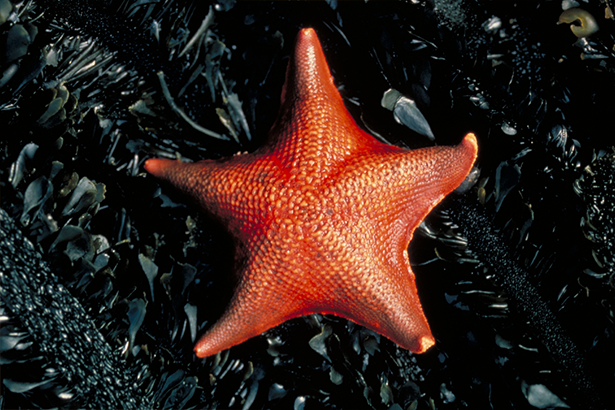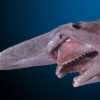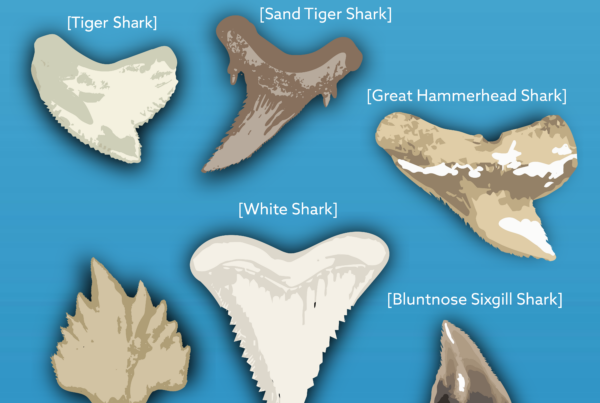No Tricks, Just Treats! We’re sharing some of our favorite sea creatures that embrace the Halloween Spirit. #FactsOverFear
Halloween Moon Crab (Gecarcinus lateralis)
The Halloween Moon Crab, nicknamed for its unique Halloween-inspired coloring. The Halloween crab is nocturnal and found on land, 20-30 ft above the highest high tide mark, along coastal regions of the western North Atlantic.
Goblin Shark (Mitsukurina owstoni)
This long-snouted animal with crazy teeth lives in the deep ocean and comes towards the surface at night. The jaws are very protrusible and can be extended almost to the end of the snout to grab prey.
Photo Credit: US Fish & Wildlife and Smithsonian Institute
Did you know that you can find spiders in the ocean too? Pycnogonida also known as sea spiders are marine arthropods which means they are related to crabs and spiders but live in the ocean! There are more than 1,300 species of sea spiders that can be found in oceans all around the world. Some of them have legs that can span as much as 2.3 feet. Like many land animals including butterflies and bees, the sea spider has a proboscis that is used to poke holes into their prey such as sponges, anemones, and jellyfish.
Video courtesy of the NOAA Office of Ocean Exploration and Research, Gulf of Mexico 2017
Witch Flounder: (Glyptocephalus cynoglossus)
Do not worry these fish will not put a spell on you! However, the witch flounder does do a little bit of magic. Like other flounders, when the witch flounder first hatches their eyes are symmetrical and are on opposite sides of their head. As they grow the fish starts to flatten out and the eyes move to the same side of its head! Their flat body and coloring make them a master in camouflage. Their diet consists of polychaete worms, but they also prey on other bottom-dwelling invertebrates like small crustaceans.
Credit: NOAA Fisheries/Northeast Fisheries Science Center
Skeleton Shrimp (Caprellidae)
These not-so-spooky skeletons are amphipods! They may look like shrimp with their elongated bodies but they are not actually shrimp. The skeleton shrimp has special colorings and slender threadlike body to help them virtually disappear within their surroundings, some species can even change color. Like all crustaceans, Skeleton Shrimp have hard exoskeletons that they shed to be able to grow.
Photo Cred: Monterey Bay Aquarium
Ghost Squid (Magnapinna sp.)
Bigfin Squid, nicknamed the ghost squid lives up to its name as it is hard to catch sightings of these big creatures. They live deeper than any other known squid which makes it hard for scientists to catch glimpses of them to do further research. The ghost squid has a distinctive appearance. Their fins are one of the most remarkable characteristics, they are extremely long compared to other squid. The largest bigfin squid was 21 feet long and the tentacles took up 20 of those feet! How they use their arms and tentacles to feed is unknown but hopefully, as research of the deep sea continues to grow we will learn more about these boo-tiful squid.
Video courtesy of NOAA Ocean Exploration, Windows to the Deep 2021.
Bat Star (Patiria miniata)
The bat star comes in many different halloweeny colors like red, orange, green, and purple. They have webbing in between their arms which gives them their batlike look! They are sometimes compared to zombies since they are scavengers that sometimes clean decaying animal tissue from the ocean floor.
Photo Cred: Monterey Bay Aquarium
Red Toothed Triggerfish (Odonus niger)
The vampire-esque red-toothed triggerfish are known for their sharp, red fang-like teeth. They are colorful fish that can change the color of their body to warn predators. The red-toothed triggerfish are found in coral reefs near Australia, Fiji, Indonesia, and Sri Lanka.
Photo Credit: Maryland Scuba Association
Ghost Shark (Chimaeriformes)
Chimaeras, informally known as “ghost sharks”, are cartilaginous fish closely related to sharks, skates and rays that are found in the deep sea. They are found in most of the world’s oceans and there are at least 38 known species of ghost sharks.
Photo Credit: NOAA Okeanos Explorer Program; Our Deepwater Backyard
Vampire Squid (Vampyroteuthis infernalis)
The vampire squid, actually isn’t a squid but a member of the vampyroteuthidae family. They are cephalopods with physical characteristics of both a squid and an octopus, but it doesn’t belong to either group. Vampire squids live in the deep sea in oxygen-minimum zones where they eat organic material that falls from the upper levels of the ocean and zooplankton. The Vampire squids also have the biggest eyes proportional to their body size out of any living animal. When startled the vampire squid turns itself inside out, inverting their cape like Dracula, and exposing spines that lie on the underside of their arms.
Photo Credit: Monterey Bay Aquarium


















